Whether you’re a seasoned camper or a newbie looking to embrace the great outdoors, a well-planned campsite can make your adventure more comfortable, efficient, and enjoyable. Finding the right campsite setup ideas can truly elevate your outdoor experience and that’s just what this post is all about.
Here are 11 great campsite setup ideas you can use:
- Organize your campsite into zones.
- Setup with the weather in mind.
- Bring an outdoor rug.
- Light your campsite up with comfort and safety in mind.
- Add a hammock to your setup.
- Create a utility area.
- Use privacy screens.
- Build a shower area into your campsite.
- Make your kitchen area as efficient as possible.
- Setup a wildlife-safety area.
- Create a first-aid station.
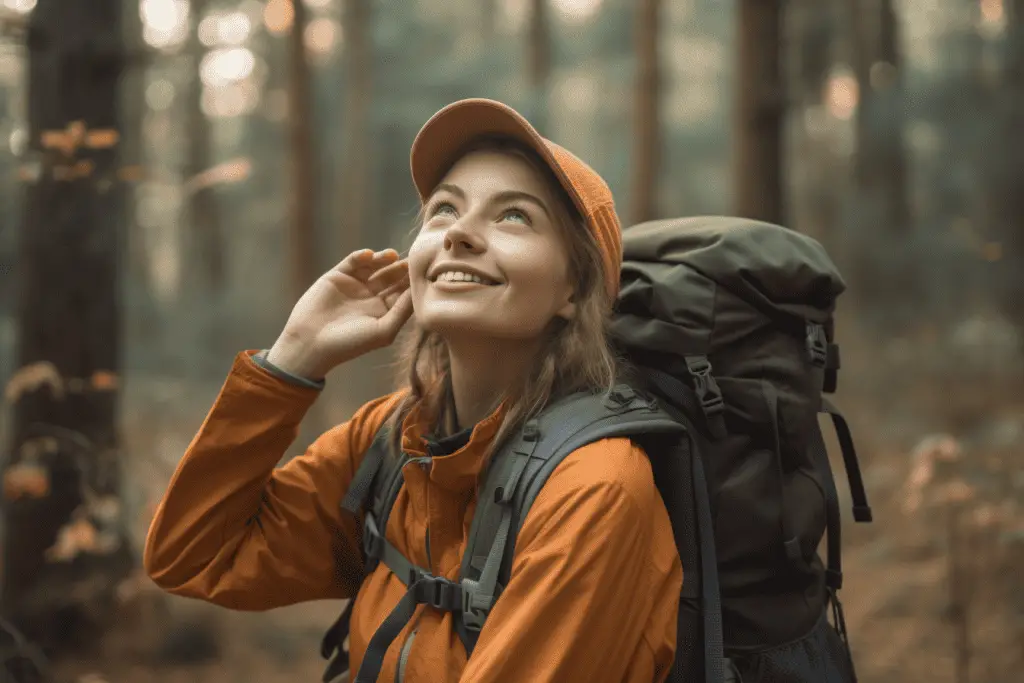
1. Get in the Zone: The Art of Zoning Your Campsite
Planning the layout of your campsite is just like arranging your own living space at home. You wouldn’t want to sleep in the kitchen, right? That’s where zoning comes in. An efficient campsite layout involves dividing your outdoor space into various ‘zones’ that cater to different needs and activities.
Sleeping Areas
Let’s start with the sleeping area. This is where your tents will be set up. It should ideally be a flat spot, away from potential disturbances like the communal fire pit or the campsite trail. Also, do consider the sunrise! Unless you’re an early bird who enjoys the first light of the day, position your tent to avoid the early morning sun.
Cooking Areas
Next up is the cooking area. This needs to be a safe distance away from the sleeping zone, both for safety and to prevent cooking smells from lingering in your sleeping space. A flat surface is perfect for balancing your stove or grill, and being near the food and utensils storage can save you a lot of back-and-forth trips.
Relaxation Areas
Then we have the relaxation area. This could be near the fire pit, where you can pull up a comfy chair, hang a hammock, or spread out a picnic blanket. This zone should ideally offer the best views the campsite has to offer, so you can enjoy your surroundings to the fullest.
Utility Areas
Finally, the utility area. This includes spots for washing dishes, dealing with trash, and any other chores that may be needed. Keeping this separate helps to maintain the cleanliness and enjoyment of the other zones.
So, whether you’re a seasoned camper or a first-timer, using these campsite setup ideas for creating a well-zoned layout can make your outdoor adventure more organized, comfortable, and, ultimately, more enjoyable. In the rest of this post, we’ll dive into each zone in detail.
2. Setup With the Weather in Mind
Now, while we’d all love every camping trip to be filled with sunshine and clear skies, Mother Nature sometimes has different plans. But don’t worry! A bit of rain doesn’t have to dampen your spirits or your camping experience. With a weather-ready setup, you can keep cozy and dry, no matter what the skies decide to do.
First things first, ensure your tent is rain-ready. A good quality tent should be waterproof, but for extra protection, using a rainfly is a great idea. This is a separate waterproof cover designed to fit over the roof of your tent. It provides an extra layer of protection against rain, giving you a dry and cozy place to sleep.
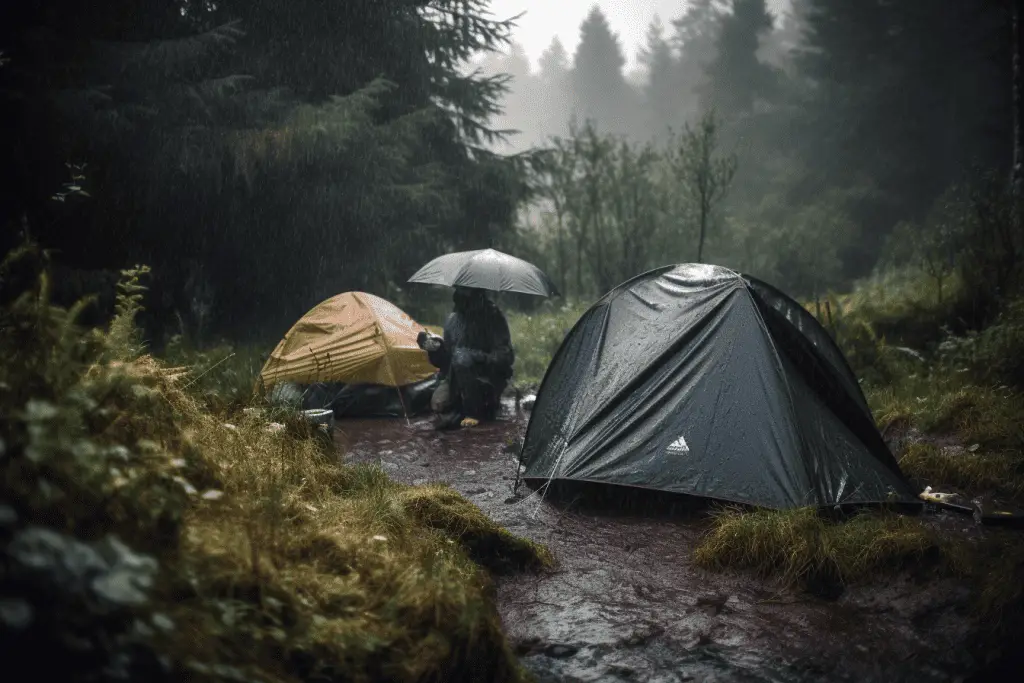
But what about your cooking and seating areas? It’s not much fun trying to cook or relax when you’re getting drenched! This is where tarps come into play. A well-placed tarp can provide a dry space for cooking, eating, and lounging, even in a downpour. Just make sure it’s secured well and angled so the rainwater runs off and doesn’t pool on top.
So, even if the forecast calls for rain, don’t be too quick to cancel your trip. With these campsite setup ideas and a weather-ready setup, you’ll be prepared to enjoy your camping experience, come rain or shine.
3. Bring an Outdoor Rug
Let’s face it, camping is fun, but no one really enjoys the dirt that can easily sneak into your tent. This is where a simple addition to your campsite setup can make a big difference: an outdoor rug. It might not be the first item you think of when packing for camping, but trust me, it can be a game-changer.
An outdoor rug acts as a fantastic barrier between you and the dirt or grass of your campsite. Place it in your tent’s entrance, and it can help to catch and collect the dirt or sand that might otherwise end up in your sleeping bag. Think of it as a doormat for your tent, helping you keep the interior clean and comfortable.
But the usefulness of an outdoor rug doesn’t stop at cleanliness. It can also be a great way to make camping more comfortable. Depending on the size of the rug, it can extend the living space of your tent, giving you a cozy spot to sit or walk barefoot. It’s especially nice if you have kids who want to play on the ground, or if you just want to kick off your boots and feel the (rug) beneath your toes.
And guess what? Your rug can be a fashion statement too. With so many designs and colors available, it’s a fun way to express your style and personalize your campsite.
So, next time you’re heading out for a camping trip, consider adding an outdoor rug to your campsite setup ideas. It’s a small addition that can significantly enhance your comfort and camping experience.
4. Light Your Campsite Up With Comfort and Safety in Mind
There’s something magical about camping under the stars, but once the sun sets, you’ll want some reliable lighting to safely navigate your campsite. The right lights can not only help prevent any late-night mishaps but also create a warm, inviting ambiance that enhances your overall camping experience.
Use a Variety of Lights
The key to effective campsite lighting is variety. Just as you would in your home, aim to have a mix of overhead and ground lights for different needs. Overhead lights hung from trees, poles, or the roof of your tent are great for general illumination, making cooking, reading, or playing games easier. Meanwhile, ground or path lights can delineate the edges of your campsite and illuminate the way to the tent entrance or bathroom facilities, enhancing safety after dark.
Take Advantage of Solar
As for what types of lights to use, solar-powered or rechargeable LED lights are your best bet. They’re efficient, durable, and environmentally friendly. Solar lights can charge during the day and provide hours of illumination in the evening, while rechargeable LED lights or lanterns are perfect for those cloudier days or heavily shaded campsites.
Bring String lights
Don’t forget the charm of string lights or lanterns for that cozy campfire ambiance. They add a beautiful glow to your campsite and are perfect for those relaxing evenings spent swapping stories or singing songs around the fire.
In short, when you’re jotting down your campsite setup ideas, make sure proper lighting is high on the list. It’s not just practical—it’s also a way to make your campsite feel more like a home away from home.
5. Add a Hammock Area to Your Campsite
When it comes to chilling out at the campsite, it’s hard to beat the humble hammock. Suspended between two trees, gently rocking with the breeze, it’s a little slice of outdoor heaven. So, if you’re lucky enough to have trees at your campsite, setting up a hammock can seriously upgrade your relaxation game.
Getting the hammock setup right is essential for comfort and safety. Start by selecting the right trees. They should be sturdy and healthy, spaced about 10 to 15 feet apart, and ideally, without any loose or dead branches overhead. Remember, it’s crucial to respect the environment, so always use tree-friendly straps that won’t damage the tree bark.
Next, hang the hammock with a nice, deep sag—think of a smiley face. This will allow you to lie diagonally across it, which is the most comfortable position and good for your back. The hammock should be about chair height (or 18 inches off the ground) for easy access.
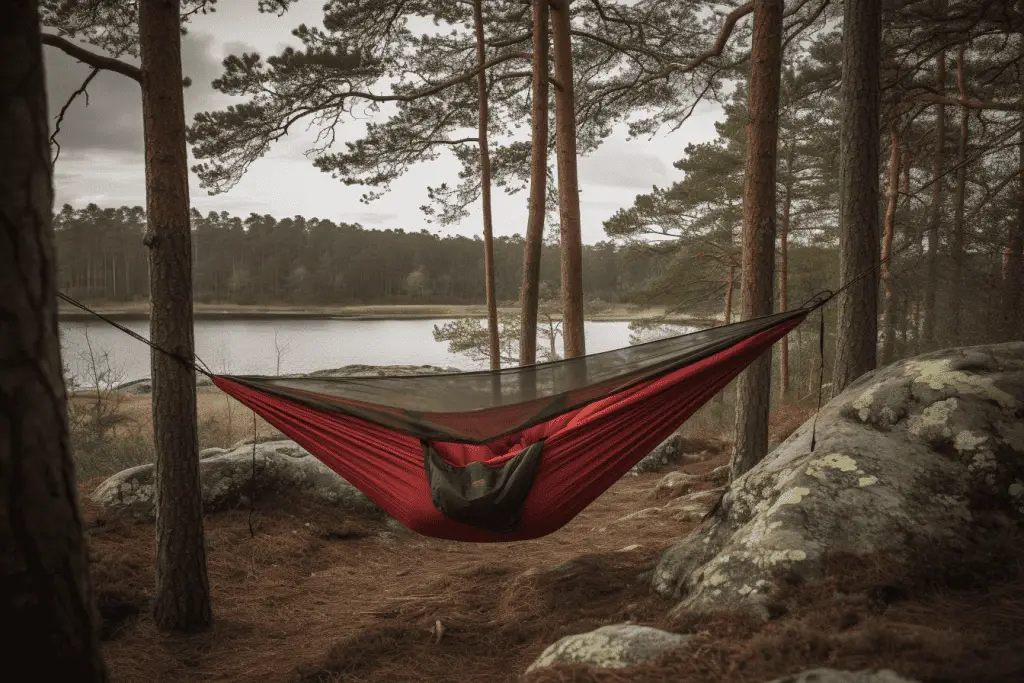
Don’t forget the extras to make your hammock setup even more enjoyable. A pillow and blanket can add comfort, while a mosquito net or tarp can be great additions for bug protection or shade on sunny days.
In the end, a hammock doesn’t just provide a cozy place to relax, nap, or read. It’s also a wonderful way to immerse yourself in nature, sway with the wind, and listen to the birds sing. So, if trees are part of your campsite setup, incorporating a hammock into your setup ideas is a no-brainer. Just don’t forget to wake up in time for s’mores!
6. Streamline Campsite Chores With a Utility Area
While camping is a great way to escape the hustle and bustle of daily life, there are still some chores that need to be taken care of. That’s where a dedicated utility area comes into play. Having a specific zone for these tasks helps keep your campsite clean and organized, allowing you to fully enjoy your outdoor adventure.
Think of your utility area as the ‘kitchen sink’ of your campsite. It’s where you’ll be washing dishes, cleaning utensils, and maybe even doing a bit of laundry if you’re on an extended trip. By keeping these tasks confined to one area, you can prevent your campsite from becoming cluttered or dirty.
To create a functional utility area, you’ll need a few key items. A collapsible sink is a great investment. It’s lightweight, portable, and can double as a storage container when not in use. Pair this with some biodegradable soap to ensure you’re not harming the environment while cleaning. Remember, it’s essential to do your washing at least 200 feet away from any water sources to prevent contamination.
For added convenience, consider a small table or a portable countertop for your dish rack and cleaning supplies. And don’t forget a trash and recycling bag to manage your waste efficiently.
In conclusion, while chores might be the last thing you want to think about when planning your campsite setup ideas, having a designated utility area can make these necessary tasks more manageable. It’s all about creating a space that’s as efficient and comfortable as possible, so you can spend less time on chores and more time enjoying the great outdoors.
7. Keep Things Private with Privacy Screens
As much as we love the openness of being in the great outdoors, there are times when a bit of privacy is appreciated. Whether it’s for changing clothes, using a portable toilet, or just escaping for a quiet moment, bringing along lightweight privacy screens or tarps can add an element of comfort and discretion to your campsite.
Privacy screens are easy to set up and can create a secluded space within your campsite. They’re especially handy if you’re at a crowded campground where your neighbors are just a stone’s throw away. Look for screens that are lightweight, easy to assemble, and with features like wind resistance for optimal functionality.
Alternatively, tarps can also serve as makeshift privacy screens. With a bit of creativity and some paracord, they can be tied between trees or poles to create a private area. They’re not only practical for privacy, but also can provide a bit of extra shade or a barrier against wind.
Consider creating multiple private spaces if needed—one for changing clothes, one for the portable toilet, and perhaps another as a quiet retreat for when you need a moment of solitude. Just be mindful of positioning these areas so they’re easily accessible but not immediately visible to your neighbors or passersby.
In the end, camping is all about connecting with nature while also ensuring comfort and convenience. By including privacy screens in your campsite setup ideas, you can enjoy the great outdoors without sacrificing personal space and privacy. It’s a small touch that can significantly enhance your overall camping experience.
8. Add a Separate Shower Area to Your Campsite
There’s no denying it: after a few days of hiking, fishing, or just lounging around the campfire, you’re going to want a shower. If you’re on a long camping trip and a traditional shower isn’t available, don’t worry. Learning how to shower while camping isn’t that difficult. A solar-powered shower bag could be the perfect solution for staying fresh and clean in the great outdoors.
A solar-powered shower bag is a simple, portable device that heats water using the power of the sun. All you need to do is fill it up with water, leave it out in the sunlight, and within a few hours, you’ll have a warm shower ready and waiting.
To set up your outdoor shower, find a sunny, private spot at your campsite. Hanging the bag from a sturdy tree branch works well, just ensure it’s at a height that’s convenient for you. An overhead tarp or a privacy screen can provide some seclusion if needed.
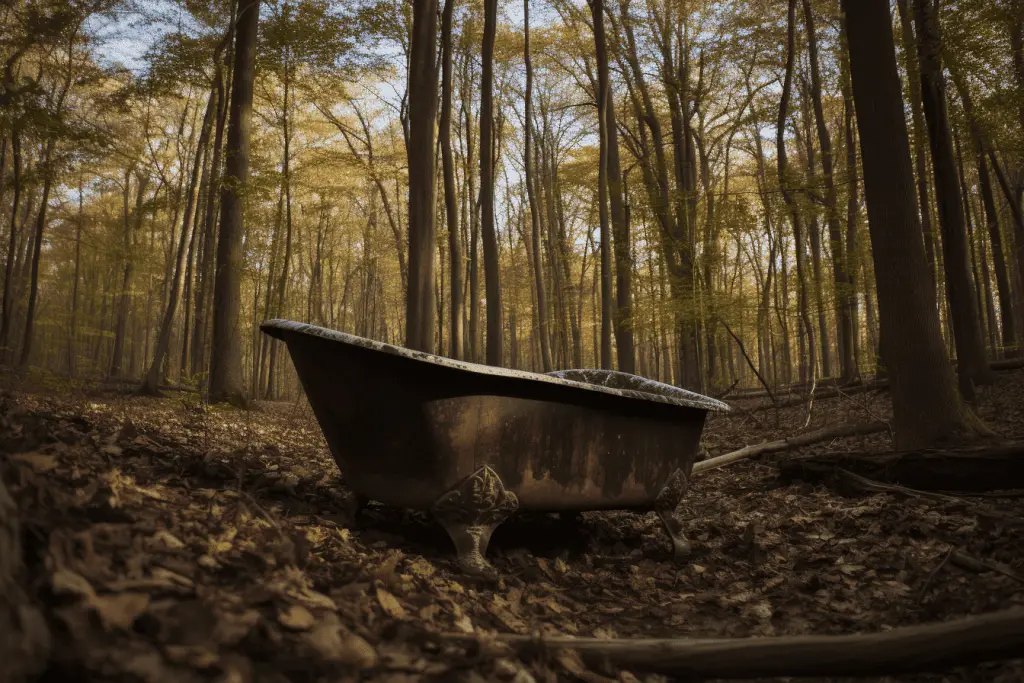
Keep in mind that these showers typically hold enough water for a quick rinse, so it’s not quite like your shower at home. The aim is to remove dirt and sweat, so you feel refreshed and comfortable. Biodegradable, eco-friendly soap is a must to ensure you’re not harming the environment.
As you can see, even when you’re deep in nature, you don’t have to sacrifice all your home comforts. A solar-powered shower is one of those campsite setup ideas that can make your long camping trip feel a little bit more like home, keeping you clean and invigorated for your next outdoor adventure.
9. Set Your Camp Kitchen Up With Efficiency in Mind
The smell of bacon sizzling in the morning air, the satisfying slurp of hot soup after a long hike, the sweet taste of marshmallows roasted over the campfire—food is a big part of the camping experience. And while campsite cooking might seem daunting, with a well-thought-out kitchen setup, you can prepare delicious meals without a hitch.
A two-burner propane stove is a perfect tool for most of your cooking needs. It’s compact, reliable, and versatile enough to handle anything from scrambled eggs to pasta. Just remember to pack enough propane for your trip and always follow safety guidelines when using it.
Now, let’s talk food storage. A cooler is essential for keeping perishable items like meat, dairy, and certain fruits and vegetables fresh. Choose a high-quality, insulated cooler, pack it with ice or ice packs, and keep it in the shade to maximize its cooling efficiency.
For your non-perishable items—think canned goods, pasta, rice, and snacks—having a well-organized storage system is key. A plastic storage bin can work perfectly for this. It’ll protect your food from animals and weather, and by separating items into zip-lock bags or smaller containers, you can easily find what you need when it’s time to cook.
Also, don’t forget cooking essentials like pots, pans, cooking utensils, plates, cutlery, and a portable coffee maker for those who need their morning brew. A small folding table can serve as your cooking station, and a water carrier is useful for having fresh water at hand.
In short, setting up your camp kitchen is all about convenience and functionality. With these campsite setup ideas, you’ll be well-equipped to cook up some unforgettable meals under the open sky.
10. Create a Wildlife-Safe Storage Area
When you’re camping in areas with wildlife, particularly where bears are present, one of the most critical aspects of your campsite setup is how you store your food. It’s not just about protecting your provisions—it’s about keeping you, your fellow campers, and the animals safe.
Bears and other wildlife are opportunistic and have an incredible sense of smell, meaning your delicious campfire dinner also smells fantastic to them. The key to preventing unwanted animal encounters is to make sure your food and any other scented items (like toothpaste or soap) are securely stowed away when not in use.
One of the most effective solutions for this is a bear canister. These are hard-sided, sealed containers that bears can’t open or easily move. Place all your food and scented items in the canister and store it a good distance away from your sleeping area to keep inquisitive bears away from your tent.
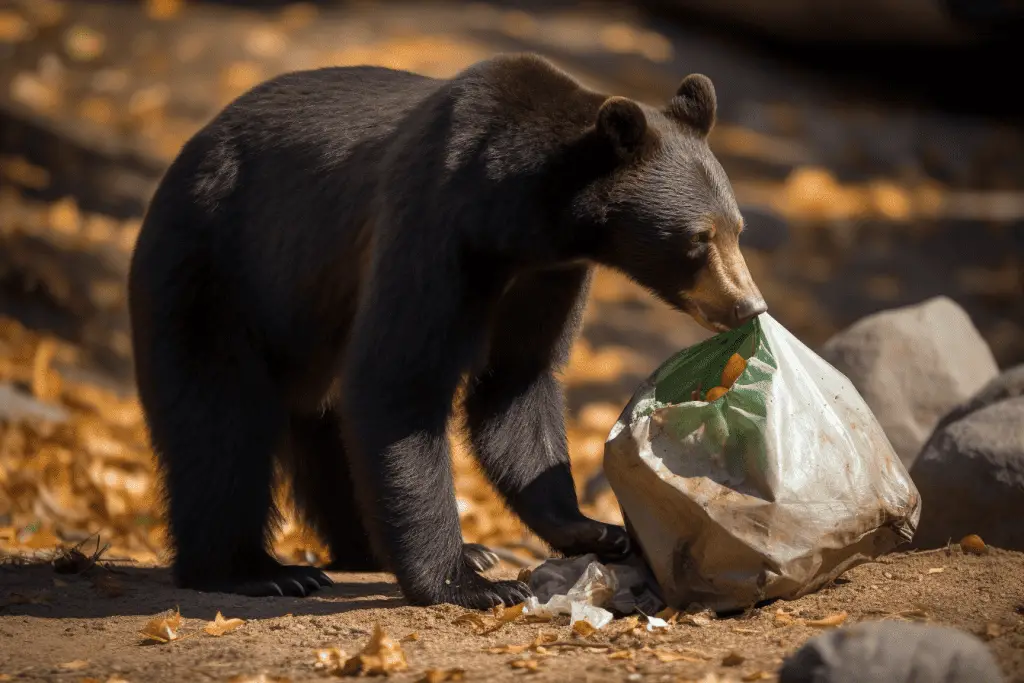
If a bear canister isn’t an option, you can use the “bear bag” method. This involves hanging a bag of food from a tree branch. The bag should be at least 10-12 feet off the ground and 4-5 feet away from the tree trunk, making it difficult for a bear to reach.
It’s important to note that these precautions are not just for areas with bear activity. Other wildlife like raccoons, squirrels, and foxes can also be drawn to your food, so safe storage is good practice wherever you’re camping.
By incorporating wildlife-safe food storage into your campsite setup ideas, you’re not just protecting your food. You’re also contributing to the wellbeing of the wildlife and ensuring that your camping adventure is safe and enjoyable for everyone involved.
11. Set Up a First-Aid Station
The peace and beauty of the great outdoors can be incredibly relaxing, but it’s also important to remember that when we venture into nature, we should be prepared for any situation. In other words, part of your campsite setup ideas should always include a plan for first aid and emergencies.
Firstly, a well-stocked first aid kit is a camping essential. It should include bandages, antiseptic wipes, tweezers, medical tape, pain relief medication, and any personal medication you or your group may need. Remember, it’s not just about having the kit—it’s also crucial that you know how to use the items in it. You may want to consider taking a basic first aid course if you haven’t already.
In addition to the first aid kit, items such as a multi-tool, flashlight, emergency blanket, and whistle are also important to have on hand. These can prove invaluable if you find yourself in an unexpected situation.
An emergency plan is another must-have. This means knowing the location of the nearest hospital or medical facility, having a reliable method of communication (like a fully charged cell phone or a satellite phone if you’re really off the grid), and letting someone who is not on the trip know your itinerary and when you plan to return.
In an ideal world, you won’t need to use any of these things. But the point of being prepared is that you’re ready to handle any situation that comes your way. So, as you’re planning your campsite setup, always give the same thought and care to your first aid and emergency preparations as you do to your cozy sleeping quarters or your campfire s’mores kit. It’s all part of making sure your camping trip is safe and enjoyable from start to finish.
Making Use of These Campsite Setup Ideas
That wraps up our deep dive into campsite setup ideas. Remember, the key to a great camping experience is not just about the destination, but also about how you set up your home away from home. With these tips and ideas, you’ll be able to create a campsite that’s not just functional, but also comfortable, safe, and conducive to making wonderful memories under the stars.
So next time you venture into the great outdoors, don’t forget to take these ideas along with your camping gear. Whether it’s using a solar-powered shower, organizing your food storage to keep wildlife safe, or simply setting up a hammock for an afternoon nap, these setup ideas can enhance your camping trip.
